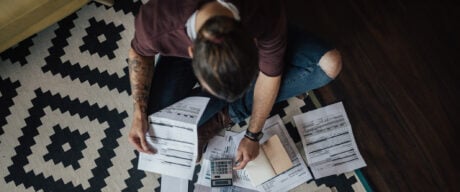Revolving credit allows you to borrow, repay and re-borrow against the same line of credit repeatedly over time. Examples of revolving credit include credit cards and home equity lines of credit (HELOCs).
Taking the time to understand the differences between revolving credit and non-revolving or installment credit will help you understand how best to use these financing options to reach your financial goals without hurting your credit.
» MORE: How to get a bank loan
How does revolving credit work?
With revolving credit, you are usually given a credit limit, or the maximum amount that you can borrow from or charge to that account. Every time you borrow money or make a purchase from the account, it uses some of that credit.
For example, if you have a $10,000 limit on your credit card and you spend $1,000, you will have $9,000 in available credit.
Every time you make a payment, you regain that amount of available credit to use when you need it. To continue the example, if you pay your $1,000 bill at the end of the month, you’d be back to $10,000 in available credit.
Revolving credit accounts are often open-ended, so there is no official limit on how long you can use them and no set number of payments after which you will have “paid off” the money you’ve borrowed. As long as you keep your account open and remain in good standing, you’ll be able to continue using a line of revolving credit. Keeping an account in good standing means making payments on time and according to the minimum amount specific in your contract.
The balance and your minimum payment may vary month to month because they depend on how much credit you have used during that time. You will pay interest only on the amount you borrow.
Examples of revolving debt
- Credit cards
- Some personal lines of credit
- Home equity lines of credit (HELOCs)
How do revolving debts impact your credit score?
Revolving debts can have an impact on your credit score in multiple ways.
Making regular payments on revolving debts, ideally by paying your bill in full, can strengthen your credit score, while missing payments or being unable to pay the minimum amounts may weaken it.
You also need to take note of your credit utilization ratio, which measures how much of your available credit you’re using and makes up a large portion of your credit score. Ideally, you’d only use 30% or less of your available credit. The more credit you have available, the more you can borrow without exceeding this benchmark. High credit utilization is a red flag that you may be overextended and it can have a negative impact on your credit score.
Finally, simply applying for and cancelling credit cards or other forms of revolving credit can impact your credit score. Applying for multiple lines of credit at once may result in several hard inquiries on your credit report, each of which can have a temporary negative effect. If you want to cancel a card, consider the impact on your credit utilization and length of your credit history to help avoid a dip in your score.» MORE:How to check your credit score
What is non-revolving (or installment) credit?
Non-revolving credit is essentially the opposite of revolving credit, more commonly known as a loan. It’s a lump sum that is borrowed and paid back over a set amount of time, typically plus interest.
Once the loan is issued, you must make required minimum payments to the lender according to an agreed-upon schedule. You don’t earn more credit room with each payment. If you need more credit, you need to take out another loan.
Examples of installment credit
How does non-revolving credit impact your credit score?
Payment history plays a big role in your credit score, so it’s important to ensure that you pay off your installment loans in a timely manner as set out in your contract. Doing this can be a big boost to your credit score. If you are unable to keep up with scheduled payments, your credit score can take a hit.
» MORE: What’s a good credit score?
What is a line of credit?
A line of credit is a type of revolving credit. It’s an agreement between you and a financial institution that allows you to borrow money when you need it, up to a maximum amount. Like other types of revolving credit, with a line of credit, you can make payments anytime and you’ll only pay interest on the amount you borrow.
Lines of credit can be secured, which means they’re attached to some form of collateral or property that secures the debt. For example, a home equity line of credit (HELOC) is secured by your home. Lines of credit can also be unsecured, which means they’re not attached to any asset. For example, a personal line of credit is typically unsecured.
Examples of lines of credit
- Personal lines of credit
- Business lines of credit
- Home equity lines of credit (HELOCs)
How does a line of credit impact your credit score?
A line of credit offers great flexibility, but a high limit might tempt you to spend more than you’re able to pay back in a timely manner, and you’ll keep paying interest as your balance grows. That balance will count as part of your credit utilization, which factors into your credit score. As with the other types of debt, it is important to keep up with required payments, since late or missed payments will hurt your score.
DIVE EVEN DEEPER

Compare Canada’s Best Credit Cards for October 2024
NerdWallet Canada’s picks for the best credit cards include top contenders across numerous card categories. Compare these options to find the ideal card for you.

Understanding the Main Types of Debt
Debt can be divided into several types: secured and unsecured, good and bad. Other types of debt include credit card debt, student loans, medical bills and mortgages.

8 New Year’s Resolutions for Dealing with Debt in 2022
Facing your balances, making a budget and choosing the right payoff strategy can help you deal with debt in the new year.

How to Get Out of Credit Card Debt
Out-of-control credit card debt can hurt your credit, affect your family and limit your financial freedom.

